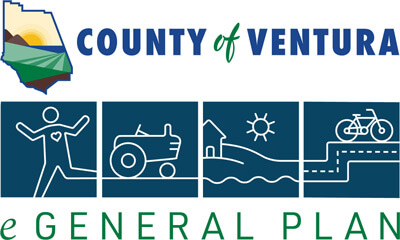There are approximately 542 centerline miles of County maintained roadways within the unincorporated area (2019). This is considered the County road network. Roads and highways within Ventura County consist of an interconnected network of federal and state highways, as well as county, city, and private roads. Private roads are not maintained by the County. The connections between these roadway systems play an important role in facilitating local, inter-county, and interstate travel. These roadways provide access to local and regional destinations, such as employment areas, shopping centers, schools, recreational areas, and residential communities. The County has designated a subset of roadways as the Regional Road Network comprised of state-, county- and city-maintained roadways. The Regional Road Network facilitates inter-city, regional and interregional travel shown in Figure 4-2. Ventura County defines its roadways by functional classification shown in Figure 4-3. The Federal Roadway Functional Classification system as applied to Ventura County is shown in Figure 4-4. Federal classifications are directly tied to federal funding eligibility. The highest federal priority network is the designated National Highway System (NHS). Roadways designated as part of the NHS in Ventura County, some of which are County-maintained roadways, are shown in Figure 4-5. The latter roadways are subject to performance monitoring and targets as established in the National Performance Management Rule (23 CFR Part 490).
Ventura County roadways also facilitate the movement of goods throughout the region and state. The Surface Transportation Assistance Act (STAA) truck routes, National and Terminal Access Routes, Primary Highway Freight System, Port Hueneme Primary Highway Freight System Routes and those local county roadways designated by the County as Overweight Vehicle Corridors are shown in Figure 4-6.
Pursuant to the 2008 California Complete Streets Act (see Gov. Code, §§ 65040.2 and 65302), certain classifications of roadways should also provide adequate right-of-way to accommodate pedestrians, bicyclists, and public transportation riders. Improving the multimodal functionality of the County’s roadway network is a key priority.
Bicycle facilities are defined using the following classification scheme:
- Class I: A Class I bike path provides a completely separated right-of-way for the exclusive use of bicycles and pedestrians with crossflow by motorists minimized.
- Class II: A Class II bike lane provides a striped lane for one-way bike travel on a street or highway and is typically designated by bike lane signs and markings.
- Class III: A Class III bike route provides a shared use area with pedestrian traffic or motor vehicle traffic (i.e., paved shoulder) and is typically designated with a bike route sign.
- Class IV: A Class IV bike lane provides a separated bike lane, or “protected bike lane” with a physical barrier between the bike lane and the adjacent travel lanes, parking lanes, and sidewalks. Class IV may be one-way or two-way. Separated bike lanes can be separated from motor vehicle traffic by raised medians, concrete curbs, landscaping, on-street parking, bollards, flexible delineator posts or by a change in elevation between the bike lane and travel lane. Providing a striped buffer between the bike lane and travel lane (i.e., no physical barrier) with restricted parking can provide the same additional separation between cyclists and motor vehicles where traditional Class IV facilities are not feasible and where Class II facilities are not adequate.
In total, the County maintains 58.2 miles of bike lanes – all but 1.56 miles are located within the shared roadway right-of-way (Class II or Class III). There are currently no Class IV bike facilities in the unincorporated areas of the County. The bikeway network in Ventura County is provided in Figure 4-7. Provision of transit service is dependent on the roadway network. Transit routes serving Ventura County are shown in Figure 4-8.
Planning for roadways near areas of new discretionary development can ensure that the roadway system maintains sufficient capacity and mobility. This section describes how the County will maintain and improve the quality of the county roadways to efficiently move people and goods on the highways and roads within and through the county.
The Ventura County Transportation Department’s priorities are public safety, ensuring roads are safe for use when used with due care in a manner in which it is reasonably foreseeable that they will be used; preservation of infrastructure; and preservation and maintenance of the public’s multi-billion-dollar investment in roads, bridges, and other facilities associated with the County road system. When funds are available, the County will strive to make operational improvements to specific areas of the road system as detailed in the Public Works Capital Improvement Plan.
